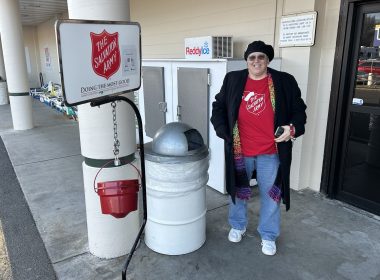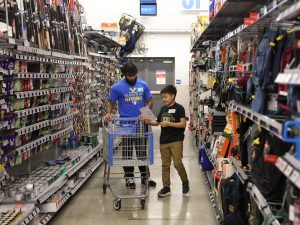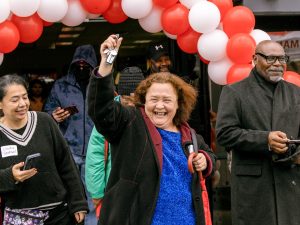The Salvation Army partners with Numana to feed earthquake survivors.
by Robert Docter –
The Lord said to Moses: “I have heard the grumbling of the Israelites. Tell them, ‘At twilight you will eat meat, and in the morning you will be filled with bread. Then you will know that I am the Lord your God.’”
The people of Israel called the bread manna. (Exodus 16)
The first food to be delivered to a hungry Haitian population following the earthquake was dropped from the heavens as manna for a needy people by The Salvation Army. A container with 288,000 Numana meals parachuted through the night, and in the morning the people had received manna from heaven.
Hunger is not satisfied by a single meal. A continual process needed to be developed, and Numana already had one in place. It involved “events” with volunteers preparing small plastic bags containing six meals per bag. One such even took place recently in Bell California.
The big gong reverberated for the last time in an elderly warehouse in Bell, CA. at 7:53 pm. It signaled a victorious completion of over 16 hours of intensive labor during which the over1,600 Salvationists and friends of the Army’s Southern California Division assembled1,000,000 (one million) meals for the homeless and hungry of earthquake ravaged Haiti.
This entire “event” took place as a result of a working relationship between SAWSO (Salvation Army World Service Organization) and the Numana Corporation, a non-profit whose goal is to save the starving of the world.
In existence for the past three years, its Numana’s CEO and founder, Rev Rick McNary expressed pleasure in the partnership as Numana provided culturally relevant, nutritious food ingredients and all the equipment needed to package the meals with the Army responsible for funding all costs, facilitating delivery, and furnishing individuals to receive and distribute the meals.
Thirty stations were set up within the Bell warehouse with l2 volunteers at each station. Each had a specific assignment during a four hour shift. Two long tables end to end formed the basic foundation of the station itself. Most packers stood and rotated through four to six assignments that required the individual to be seated. The first worker attached a small, plastic bag to the bottom of a suspended funnel shaped device and held the bag in place; the second added a cup of soy protein to the top of the funnel; the third poured in a cup of rice. The bag remains on the funnel and #4 adds a scoop-spoon of freeze-dried vegetables and chicken bouillon; with #5 adding a spoon of vitamins. Numbers six and seven seal the bag with a heated sealer, and numbers #8 and #9 flatten the bag and lay it in a numbered location for packing 11 bags in a small box. The box packer is #10, and the station coordinator, #11, places four completed small box inside a larger box for a carrier, #12, to cart to a pallet to be included in a full skid of boxes for shipping to Miami and then flown to Haiti.
The flow must go on, and the several hundred in attendance for the entire shift rapidly develop somewhat of a party atmosphere with whistles and shouts across the room as tables compete with one another and the gong signals every time 5,000 meals are added to the mix.
Participants came from all over southern California – as far north as June Loo’s service extension center in San Luis Obisbo. Many learned of the event from Facebook “friends,” and several corps, ARC’s, divisional and territorial headquarters officers and employees participated.
The Lord said to Moses: “I have heard the grumbling of the Israelites. Tell them, ‘At twilight you will eat meat, and in the morning you will be filled with bread. Then you will know that I am the Lord your God.’”
The people of Israel called the bread manna. (Exodus 16)
The first food to be delivered to a hungry Haitian population following the earthquake was dropped from the heavens as manna for a needy people by The Salvation Army. A container with 288,000 Numana meals parachuted through the night, and in the morning the people had received manna from heaven.
Hunger is not satisfied by a single meal. A continual process needed to be developed, and Numana already had one in place. It involved “events” with volunteers preparing small plastic bags containing six meals per bag. One such even took place recently in Bell California.
The big gong reverberated for the last time in an elderly warehouse in Bell, CA. at 7:53 pm. It signaled a victorious completion of over 16 hours of intensive labor during which the over1,600 Salvationists and friends of the Army’s Southern California Division assembled1,000,000 (one million) meals for the homeless and hungry of earthquake ravaged Haiti.
This entire “event” took place as a result of a working relationship between SAWSO (Salvation Army World Service Organization) and the Numana Corporation, a non-profit whose goal is to save the starving of the world.
In existence for the past three years, its Numana’s CEO and founder, Rev Rick McNary expressed pleasure in the partnership as Numana provided culturally relevant, nutritious food ingredients and all the equipment needed to package the meals with the Army responsible for funding all costs, facilitating delivery, and furnishing individuals to receive and distribute the meals.
Thirty stations were set up within the Bell warehouse with l2 volunteers at each station. Each had a specific assignment during a four hour shift. Two long tables end to end formed the basic foundation of the station itself. Most packers stood and rotated through four to six assignments that required the individual to be seated. The first worker attached a small, plastic bag to the bottom of a suspended funnel shaped device and held the bag in place; the second added a cup of soy protein to the top of the funnel; the third poured in a cup of rice. The bag remains on the funnel and #4 adds a scoop-spoon of freeze-dried vegetables and chicken bouillon; with #5 adding a spoon of vitamins. Numbers six and seven seal the bag with a heated sealer, and numbers #8 and #9 flatten the bag and lay it in a numbered location for packing 11 bags in a small box. The box packer is #10, and the station coordinator, #11, places four completed small box inside a larger box for a carrier, #12, to cart to a pallet to be included in a full skid of boxes for shipping to Miami and then flown to Haiti.
The flow must go on, and the several hundred in attendance for the entire shift rapidly develop somewhat of a party atmosphere with whistles and shouts across the room as tables compete with one another and the gong signals every time 5,000 meals are added to the mix.
Participants came from all over southern California – as far north as June Loo’s service extension center in San Luis Obisbo. Many learned of the event from Facebook “friends,” and several corps, ARC’s, divisional and territorial headquarters officers and employees participated.












